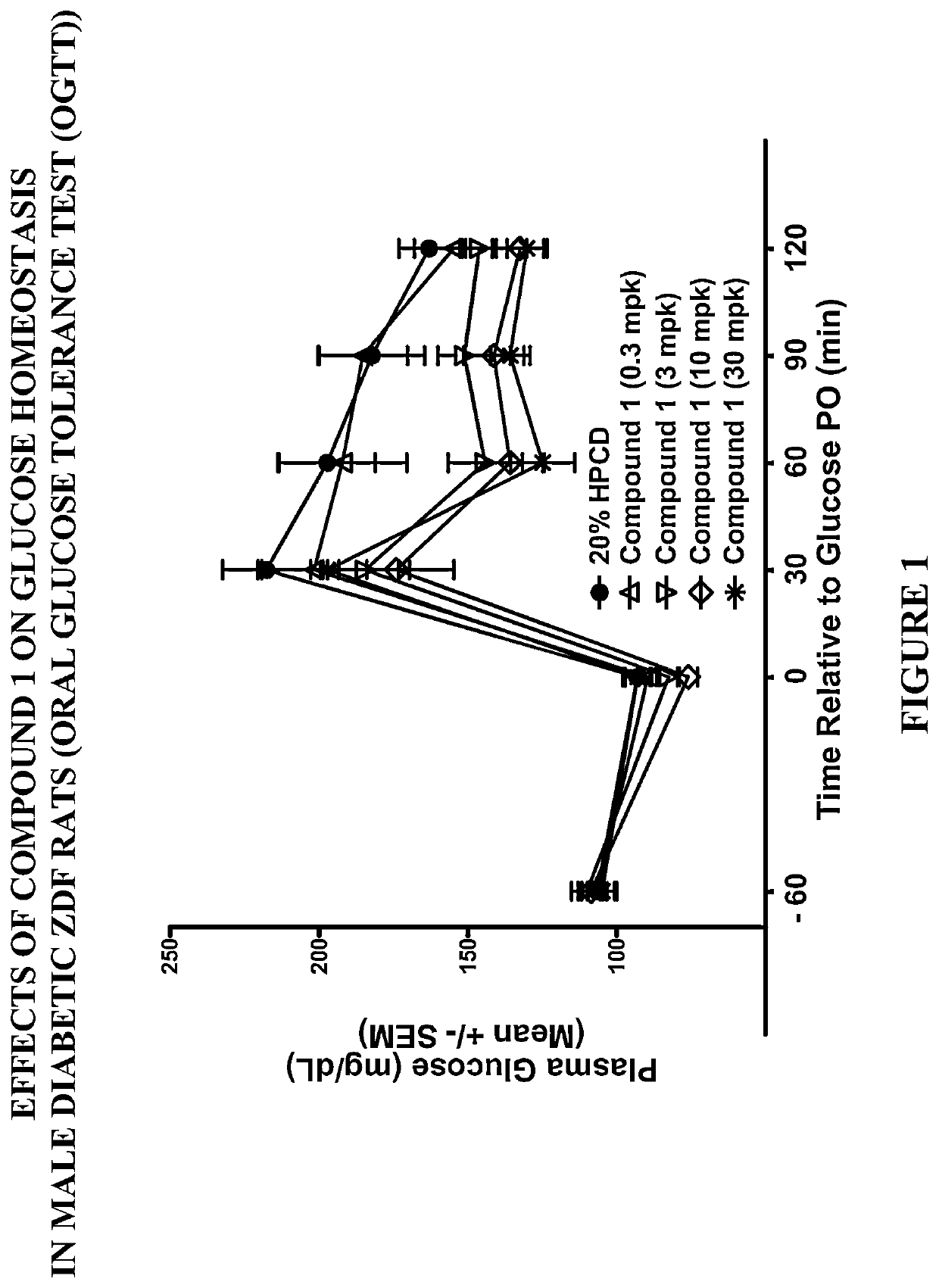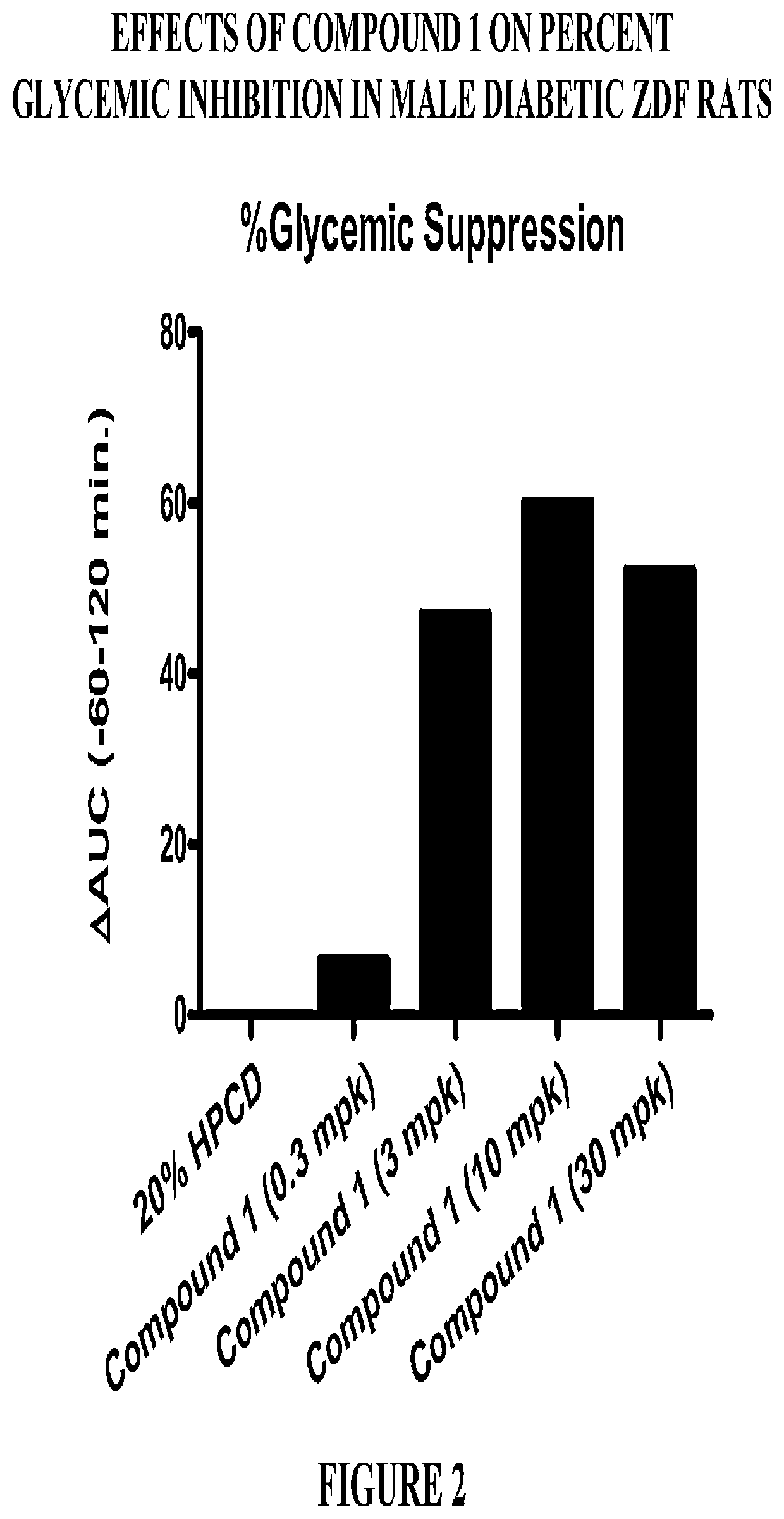Modulators of the GPR119 receptor and the treatment of disorders related thereto
a technology of gpr119 receptor and gpr119 agonist, which is applied in the direction of metabolism disorders, extracellular fluid disorders, peptide/protein ingredients, etc., can solve the problems of not producing insulin, not efficiently using, and not moving glucose into their cells, so as to and increase the secretion of incretin
- Summary
- Abstract
- Description
- Claims
- Application Information
AI Technical Summary
Problems solved by technology
Method used
Image
Examples
example 1.1
Preparation of 5-Fluoropyrimidine-4,6-diol
Method A
[0495]To a three-neck round-bottom flask equipped with an overhead stirrer, nitrogen flow, and reflux condenser, was added 25 wt % sodium methoxide in methanol (950 mL, 4.15 mol) and formamide (357 mL, 8.98 mol). The mixture was heated to about 64° C. To the reaction mixture was added diethyl 2-fluoromalonate (177 mL, 1.12 mol) using an addition funnel over 1 h. The reaction temperature was maintained at 64° C. for 72 h. The reaction mixture was allowed to cool to room temperature and the solvent was removed under reduced pressure. The residue was cooled to 0° C. and slowly acidified with concentrated hydrochloric acid to pH 1-2 resulting in the precipitation of the product. The product was filtered and washed with an ice cold aqueous 1 N HCl solution. The off-white solid was suspended in acetonitrile, filtered and dried in a vacuum oven to give 5-fluoropyrimidine-4,6-diol (170 g, 1.31 mol) as a light brown-pinkish solid which was us...
example 1.2
Preparation of 4,6-Dichloro-5-fluoropyrimidine
Method A
[0497]To a 500 mL three-neck round-bottom flask containing phosphorus oxychloride (45.3 mL, 487 mmol) was slowly added 5-fluoropyrimidine-4,6-diol (20.0 g, 154 mmol) and the resulting reaction mixture was heated to 60° C. To the resulting slurry was slowly added N,N-dimethylaniline (42.2 mL, 331 mmol) over 4 h using a syringe pump and the reaction mixture was stirred at 60° C. for 16 h. The reaction mixture was cooled to room temperature and slowly added into a mixture of brine and ice (400 mL) with stirring. The aqueous layer was extracted with dichloromethane (2×250 mL). The combined organic layers (light amber) were washed with cold aqueous 6 N HCl solution (200 mL), dried over sodium sulfate, and filtered through a glass fiber paper by vacuum filtration and the solvent was removed under reduced pressure (no heat) to give 4,6-dichloro-5-fluoropyrimidine (13 g, 78 mmol, 50.6% yield) as an amber oil. 1H NMR (400 MHz, CDCl3) δ pp...
example 1.3
Preparation of 2-Fluoro-2-methylpropanenitrile
Method A
[0499]To a 1 L three-neck round-bottom flask containing 2-hydroxy-2-methylpropanenitrile (120 mL, 1.31 mol) at 4° C. was slowly added (diethylamino)sulfur trifluoride (DAST) (172 mL, 1.31 mol) over 1 h via an additional funnel. The reaction mixture was allowed to warm to room temperature and stirred overnight. The mixture was directly purified by vacuum distillation (40-45° C. / 45 mmHg) to provide 2-fluoro-2-methylpropanenitrile (83.36 g, 0.957 mol, 73.0% yield) as a colorless oil containing methacrylonitrile (˜10%). 1H NMR (400 MHz, CDCl3) δ ppm 1.77 (d, J=20 Hz, 6H).
Method B
[0500]2-Hydroxy-2-methylpropanenitrile (CAS #75-86-5, 221 mL, 2.420 mol) was cooled down to −10° C. (ice / acetone / dry ice) in a 1 L three necked round bottomed flask and DAST (246 mL, 1.861 mol) was added slowly using an addition funnel over a period of 2 h. Once the addition was finished, the reaction was allowed to warm up to room temperature and stirred ove...
PUM
| Property | Measurement | Unit |
|---|---|---|
| 2θ | aaaaa | aaaaa |
| 2θ | aaaaa | aaaaa |
| 2θ | aaaaa | aaaaa |
Abstract
Description
Claims
Application Information
 Login to View More
Login to View More - R&D
- Intellectual Property
- Life Sciences
- Materials
- Tech Scout
- Unparalleled Data Quality
- Higher Quality Content
- 60% Fewer Hallucinations
Browse by: Latest US Patents, China's latest patents, Technical Efficacy Thesaurus, Application Domain, Technology Topic, Popular Technical Reports.
© 2025 PatSnap. All rights reserved.Legal|Privacy policy|Modern Slavery Act Transparency Statement|Sitemap|About US| Contact US: help@patsnap.com



